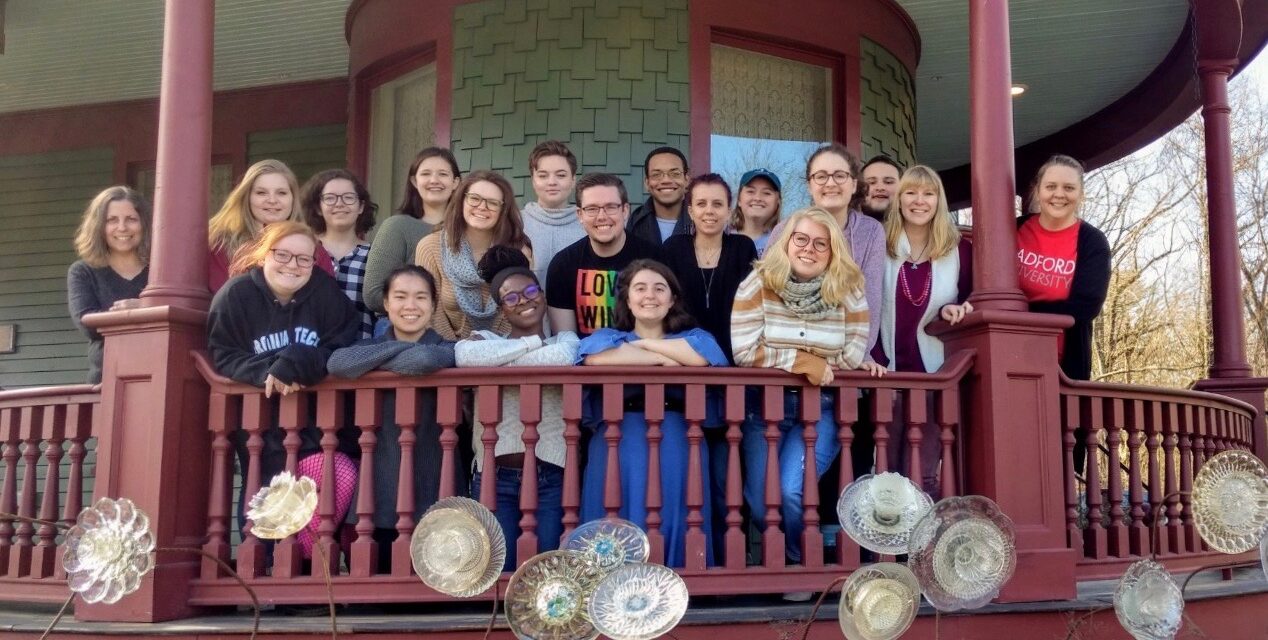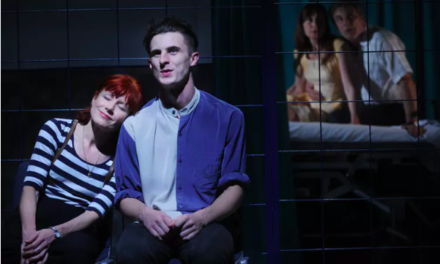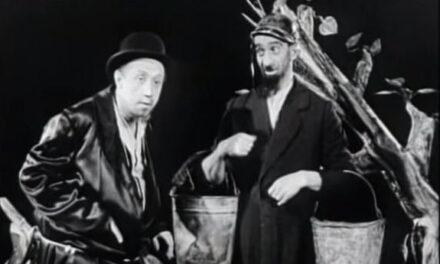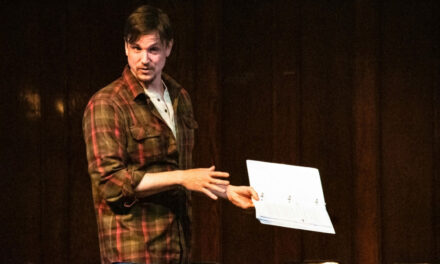Leaders of the women’s suffrage movement relied on public performance to promote their cause. They used marches, plays, and demonstrations at baseball games to recruit women to join their efforts and to persuade men to vote for legislation that would expand voting rights. The more radical suffragists are credited as the first group to protest at the White House, which they did to try to sway President Woodrow Wilson to support the movement.
So theater seemed like a fitting medium for marking the 100th anniversary of the Nineteenth Amendment in 2020, agreed Molly Hood, assistant professor in the Department of Theatre and Cinema at Radford University, and Amanda Nelson, associate professor in the School of Performing Arts at Virginia Tech.
“This centennial is an opportunity to share the voices that haven’t been heard before,” Nelson says. “What better way to give voice than through a theatrical production?”
With that idea in mind, the pair set out to put on a show. They had several goals for the process. The professors wanted students at their neighboring campuses to have the opportunity to collaborate. They wanted to integrate two branches of theater scholarship: history and performance. And they wanted to experiment with an alternative performance setting.
So the two professors devised a joint Friday course that would invite Radford and Virginia Tech students to write a theater piece about the suffrage movement. At the end of the semester, they would perform it at a nearby Victorian house museum.
“I think the obvious metaphor of the home being the women’s sphere at the time, it was a good fit,” Nelson says.
The class got off to a strong start in January with a diverse cohort of students. To get a feel for how suffragists communicated 100 years ago—and to build connections between campuses—the students corresponded via letters to assigned pen pals. A few weeks in, they gathered together for a potluck breakfast and a visit to the house museum where they planned to perform.
Then the pandemic hit. Students left Radford and Virginia Tech. Live theater was canceled.
But the class wasn’t.
“Neither of us ever said, ‘Forget it,’” Hood says. “Our students, they all wanted to know, ‘What are we doing?’ We came to them with this insane idea.”
They would create an interactive, online production staged in a virtual Victorian mansion.
Hood and Nelson quickly realized they needed help to build the “special performance website” they envisioned. They recruited a scenic designer and faculty member from Radford to draw the house, and a web developer from the Virginia Tech Institute for Creativity, Arts, and Technology to provide technical expertise. Meanwhile, their students learned how to record audio and video versions of the character monologues they were writing.
“Stage performance is different than film or audio. If you just have audio, you only have your voice. Clarity, landing sentences, really paying attention to the structure of a sentence, becomes important,” Nelson says. “Students got a broader sense of the skills and approaches to different mediums—a crash course.”
The performance website, “Women and the Vote,” premiered on May 18. Users navigate through the house by interacting with the suffrage movement artifacts on display in each room, which link to recorded monologues, songs, artwork, and research text. In intimate scenes, students portraying suffragists including Maggie Walker, Mabel Ping-Hua Lee, and Alice Paul share glimpses of their thoughts and feelings.
For audience members, the choose-your-own-adventure style of the piece has been appealing, the professors say. They’ve heard from friends who have explored the house with their young daughters.
For the students, seeing their research and creative work culminate in a digital production that could be widely shared was rewarding, especially given the context of the pandemic, which has thrown the theater community into a “revolution,” Hood says.
For many performing arts students, she adds, “this was the only product from the spring semester that got seen to its conclusion.”
And for the professors, the experience allowed them to bring to life a concept they’ve been developing called “performing history,” which binds civics, history, and creative performance. To that end, the piece underscores the ties between the past and present. For instance, users who click on the garden of yellow roses—a symbol of the suffrage movement—are invited to register to vote online.
“We were trying to encourage conversation and dialogue on the history and our current state of affairs,” Nelson says. “Hearing students talk about not taking the vote for granted—their own awakening of responsibility was found through this process.”
Student Podcast Explores Activism at Women’s Colleges
Meanwhile, students at another college also used digital media to share stories of the suffrage movement. They spent the last year discovering the role that women’s colleges and campus organizations played in the fight for women’s voting rights.
The research, documented in a podcast, was a little bit personal. That’s because the students, Morgan Johnson and Marissa Fowler, attended Meredith College, a women’s institution in North Carolina founded in the late 1800s. It’s a place, Johnson says, where the “idea of sisterhood” is important.
But a century ago, college sisters harbored varied opinions about women’s suffrage and differing goals for how they would use the vote if they won it. That’s what Johnson and Fowler discovered as they looked through archived yearbooks, literary magazines, and scrapbooks from North Carolina women’s colleges from 1910 to 1922. Some women proudly called themselves suffragists and were members of a campus club called the Equal Suffrage League. But not everyone was active in promoting the cause.
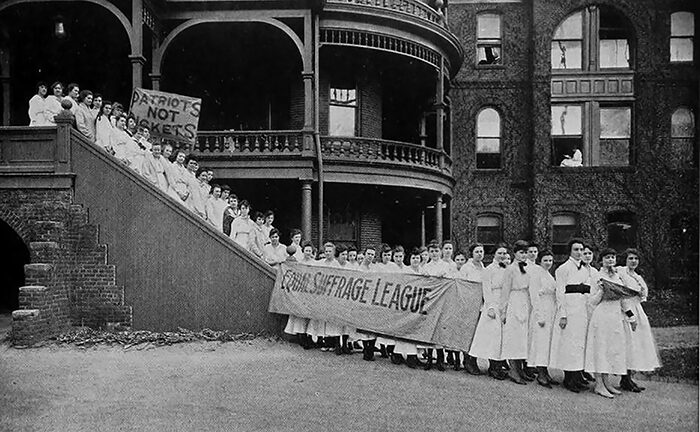
Student members of the Meredith College Equal Suffrage League in 1918-1919. PC: Meredith College Archives.
“We didn’t find strong anti-suffragist messages in anything we looked at. There were some jokes that might have been a little sarcastic,” Fowler says. “It felt like most students were neutral on the subject, or pro-suffrage.”
Yet even some supporters showed ambivalence about the idea of women jumping into public life, preferring “a very feminized version of political activity,” Johnson says.
“We did find a few examples of students kind of being a little wary of suffragist stereotypes, because North Carolina was a more conservative state,” she adds. “I think that southern culture played a role in what suffrage looked like in these campuses.”
Identifying college student activism is easier when it’s overt. For example, the marchers in the 1913 Women’s Suffrage Parade in D.C. included the first members of Delta Sigma Theta sorority, which had recently formed at Howard University.
Yet women college students organized to expand their rights in ways that were less conspicuous, too. Political activity among people who lack power isn’t always “very loud, very literal, very obvious,” says Crystal A. deGregory, a research fellow at the center for historic preservation at Middle Tennessee State University and the founder of media and research organization HBCUstory.
That’s especially true for Black women students, she adds, like those from Delta Sigma Theta, who had to grapple with racism as well as sexism in their fight for enfranchisement.
“Even social gatherings were a political act for Black people,” deGregory says. “There was much more afoot than what appeared to the casual observer, which may have been women gathering anywhere for tea, for book club, for sewing club. They sipped tea and they sewed tapestry and they sought to devise ways and means to chip away at the foundation that was holding up racism and white supremacy in wider society.”
Johnson and Fowler say their podcast is missing parts of the story of suffrage activism among women college students. They captured mostly white women’s efforts, because North Carolina women’s colleges accepted only white students during the period they studied and because the state’s historically Black women’s university, Bennett College, was co-educational at the time.
And when the researchers tried to trace what happened to self-identified suffragist students after they left their universities, they discovered that it can be difficult to follow women through history.
“The thing [about] doing research on women is, women get married and their names change,” Johnson says.
Newspaper coverage of women was often relegated to “a society page about them going to a party or to a wedding,” Fowler says, “which is not what we were looking for.”
Still, Fowler and Johnson are proud of the research they were able to conduct and of the podcast they recorded, which includes interviews from historians and voice acting from theater students.
“I found it interesting to see the ways student life is the same and completely different at once,” Fowler says. “We have some of the same traditions at Meredith now that the girls were doing 100 years ago.”
This article was originally published on edsurge.com on August 20, 2020, and has been reposted with permission. To read the original article, click here.
This post was written by the author in their personal capacity.The opinions expressed in this article are the author’s own and do not reflect the view of The Theatre Times, their staff or collaborators.
This post was written by Rebecca Koenig.
The views expressed here belong to the author and do not necessarily reflect our views and opinions.

